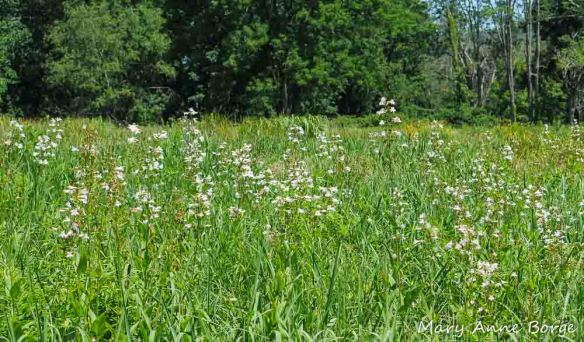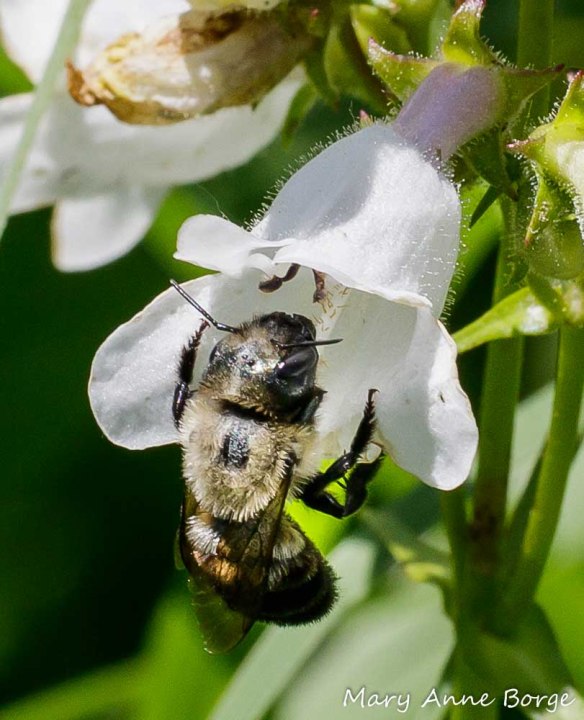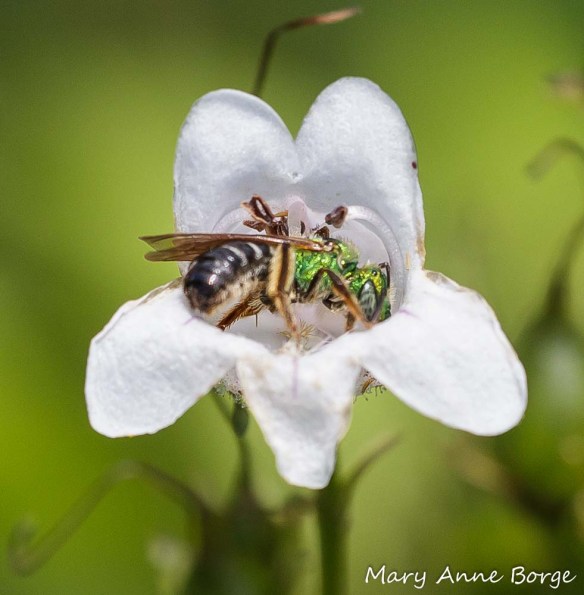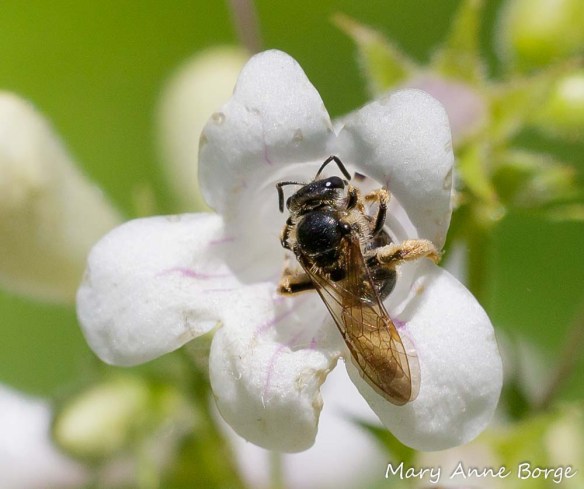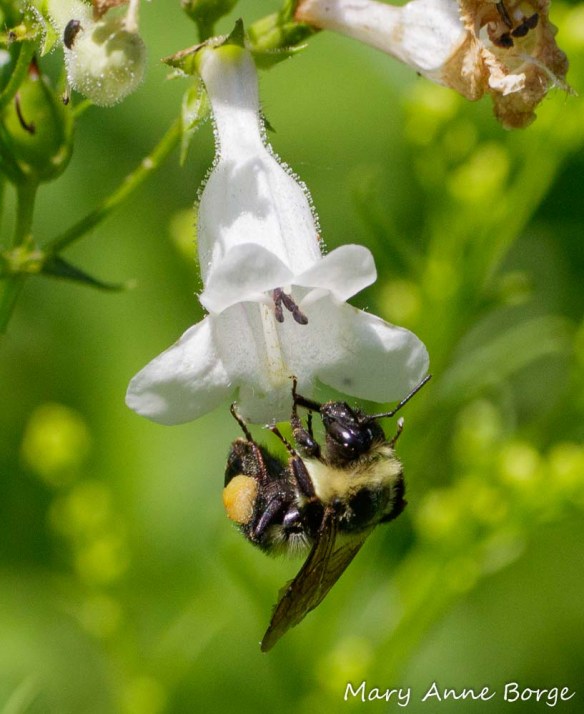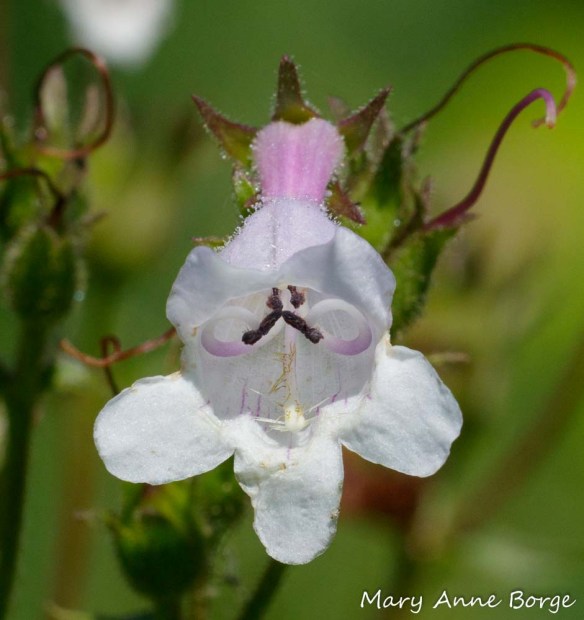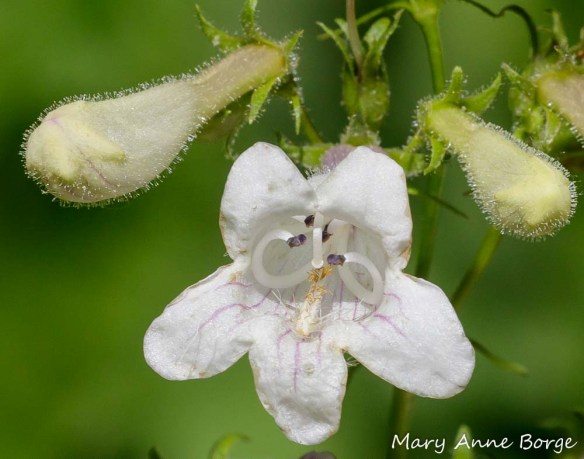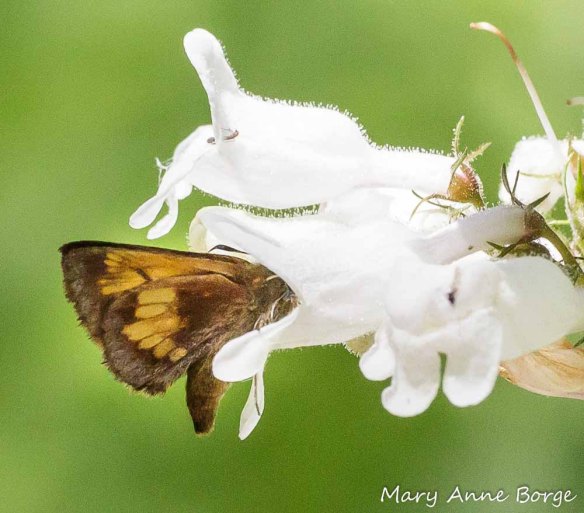White Beardtongue for Pollinators
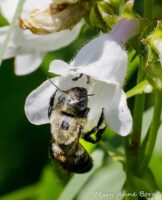
From The Natural Web:
White or Foxglove Beardtongue (Penstemon digitalis) blooms in late spring to early summer, offering nectar and pollen to flower visitors. It’s easy to recognize in fields and along roadsides by its upright habit and its inflorescence of many whitish flowers, all positioned perpendicularly to the stem. The name Penstemon reflects the fact that these flowers each have five male flower parts, called stamens. ‘Foxglove’ and ‘digitalis’ both refer to the shape of the flowers, which resemble those of Foxglove (Digitalis purpurea).
The white flowers beckon to a variety of bees who are enticed by the possibility of a meal of nectar and pollen, with the purple lines (nectar guides) on the throat of the flower showing them the way.
In addition to feeding themselves, female bees also harvest pollen and nectar to provision their nests for their larvae. But if bees are eating and harvesting the pollen, how will the flowers be pollinated? Will there be any pollen left to fulfill the plant’s goal of reproduction?
Female Bumble Bee on White Beardtongue (Penstemon digitalis). Note the harvested food on her hind leg.
Although much of its pollen is used to entice and reward insect visitors, White Beardtongue’s strategy is to deposit pollen on its flower visitors’ bodies in a place that can’t be easily reached for grooming.
The flowers have both male and female parts, but they are sequentially unisexual. The male flower parts, or stamens, mature first, with the anthers at their tips opening up to release pollen. Although White Beardtongue has five stamens, only four are capable of producing fertile pollen. These four stamens are all positioned just below the ‘roof’ of the flower tube, or corolla. The dark brown anthers, which contain the pollen, are at the tips of the stamens, clustering above the center of the entrance to the flower.
White Beardtongue (Penstemon digitalis) in the male phase. The dark brown anthers are clustered just below the center of the ‘roof’ of the flower.
When the flowers are in this phase, a visitor like the Bumble Bee in the photo below may enter the flower, and be brushed with pollen on the top of its head, thorax or even its tongue (proboscis).
After a day or so, the anthers begin to wither and the female flower part begins to mature, the sticky stigma at its tip becoming receptive to pollen. The style extends and curves downward, taking the same position that the anthers once held.
White Beardtongue (Penstemon digitalis) in the female phase. The stigma has replaced the anthers just below the center of the ‘roof’ of the flower.
If a bee carries the pollen to a flower in the female phase, it will generally enter the flower in the same way, depositing the pollen on the receptive stigma. Success! White Beardtongue’s pollination strategy has worked.
Bumble Bee depositing pollen on stigma of a White Beardtongue (Penstemon digitalis) in the female phase.
Some pollen may fall on the ‘floor’ of the flower, where the fifth stamen is positioned. This stamen is sterile; it does not produce its own pollen. It is somewhat hairy, giving the plant its common name ‘beardtongue’. This hairy stamen may catch some of the fallen pollen and deposit it on an insect visitor as it brushes past, a secondary means of pollen dispersal. Some smaller bees may cling upside down while foraging for pollen.
Butterflies and even hummingbirds may stop by for nectar. They may not be as effective in pollinating White Beardtongue as the bees are if their anatomy and behavior is not as good a match for the anatomy of the flower. On the plus side, neither butterflies nor hummingbirds harvest pollen, so any that does adhere to them has the possibility of being deposited on another flower.
Hobomok Skipper butterfly visiting White Beardtongue (Penstemon digitalis) for nectar. It may be just the right size to pick up or deliver pollen on its head.
White Beardtongue blooms for a period of about a month in June to early July. It is native in the eastern two-thirds of the United States, and is found in several Canadian provinces. It can tolerate sun to part shade in dry to somewhat moist, well-drained soil, and grows to a height of 2-5 feet (6 – 15 decimeters). It’s a good addition to a natural area or a pollinator garden.
A Tribute To The Monarch Butterfly
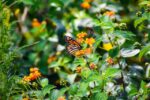
Helping Monarch butterflies to thrive in your garden requires some basic knowledge of their life cycle and migration paths so that you know how to support them through these two journeys they take in their lifetime. You will also need some ideas for garden layouts and plants they love. Thanks to Hermann Samano and Porch for sending this comprehensive article about how to turn your back yard into a butterfly friendly habitat!
Benefits of Bats, Bat Houses and Bat FAQs

Benefits of Bats
Many people have serious misconceptions about bats. Myths that they are vicious carriers of rabies and pests are abundant. The fact is that bats are actually quite harmless and are important indicators of a healthy environment. Because bats are sensitive to high pollution and pesticide levels, they are useful as a warning sign to potential environmental problems. Bats can also be important weapons in combating insects that are actually dangerous to humans.
Scouts are “Going Batty” at the Potting Shed

Local Girl Scouts have recently received the gift of 24 bat house box kits from the Rowayton Gardeners and are a step closer to earning a badge for their efforts in assembling, staining and distributing the bat homes throughout our community. The boxes will be mounted on 15 foot poles in public gardens on properties owned by the Norwalk Land Trust and Rowayton Historical Society as well as several tended by the Gardeners for the 6th Taxing District. The girls are learning about the benefits of having bats in our neighborhood. Continue reading“Scouts are “Going Batty” at the Potting Shed”
Natural History magazine covers our Pollinator Pathway

“A grass-roots movement is transforming traditional landscapes into pollinator way stations”, writes Susan Shea in the April issue of Natural History. “Amidst the historic homes, posh estates and manicured lawns of southwestern Connecticut, a new, almost radical, movement is gaining strength.” Read the entire article here.
The Hummingbirds Are Coming…
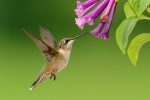
Check out this article from Audubon Society about when to expect migrating hummingbirds in your yard and how to attract and feed them: When to Expect Hummingbirds in Your Yard This Spring.
Creating a Pollinator Paradise in Your Backyard
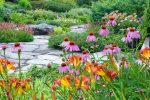
Rowayton Gardeners are proud participants in the Pollinator Pathway and we encourage all residents to plant for pollinators. This wonderfully graphic article by Alice Ely is a terrific guide for us all as it includes information on natives and non-natives, perennials and annuals that provide food and habitats for bees, butterflies, moths, bats and birds.
It IS Easy Being Green
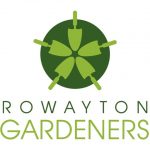
Pledge Your Yard as a Pesticide-Free Zone! Organic lawn and garden care is friendly to pollinators, birds and humans. Going organic doesn’t mean you have to sacrifice an aesthetically pleasing lawn and it certainly doesn’t mean that you have to devote long hours to tending your lawn. It DOES mean planting what will do well in our climate, watering deeply but infrequently and finding safe alternatives to expensive fertilizers and harmful pesticides. Here are a few steps you can take to ‘Go Organic’:
Pollinator Garden Plants and Practices

Enjoy this lengthy, detailed and illustrated article from the Nature Conservancy as they “explore the intimate connections plants and pollinators depend on for survival and how this understanding can enhance our own efforts when gardening for wildlife.” See the full article here.
8 Steps to Design a Native Plant Landscape

Gardenista says, “When it comes to pollinator gardens, not all are created equal. In fact, we were surprised to learn that many plants advertised as “pollinator friendly” actually do more harm than good, either because they do not support the entire life span of pollinators and threaten native species that do, or because they are grown with toxic pesticides that can remain for years. For the conscientious garden, a chemical-free, native pollinator garden is the best choice.” Read the article here.
Gardening for Wildlife

Would you like to know how to create a sustainable garden that helps wildlife find food, water, shelter and a safe place to raise their young? May is designated by National Wildlife Federation as “Gardening for Wildlife” month and a new section of their website will provide all the pointers you need. check it out!
Wildflowers for Pollinators with Blooming Seasons

Pollinator Pathway has created a terrific illustrated guide to plants that will attract hummingbirds, bees, butterflies and other pollinators through most of the year. Plan your buffet for the bees with this handy chart.Continue reading“Wildflowers for Pollinators with Blooming Seasons”
Organic Grub Control Options

From Protect our Pollinators, here is a way to prevent grubs in your lawn without using products that can harm our insect friends. It involves some common sense organic steps to diagnose and then control the grubs that can decimate lawns.Continue reading“Organic Grub Control Options”
Native Shrubs, Trees and Plants for Pollinators
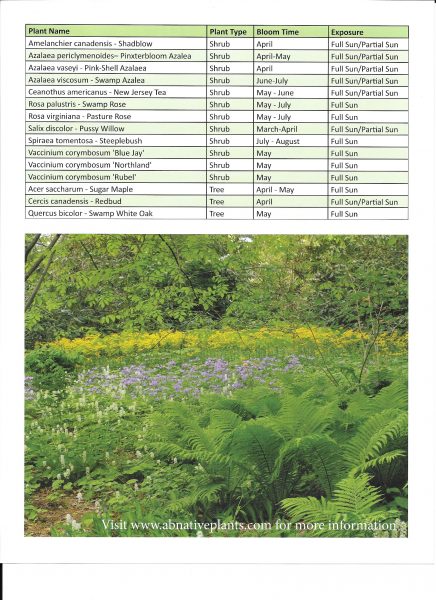
American Beauty Native Plants has put together a list of native shrubs and trees that pollinators love. See their website for more information, but this list includes plant type, bloom time and preferred exposure. A second list includes native plants that will attract pollinators…have a look!Continue reading“Native Shrubs, Trees and Plants for Pollinators”
Connecticut Trees for Pollinators
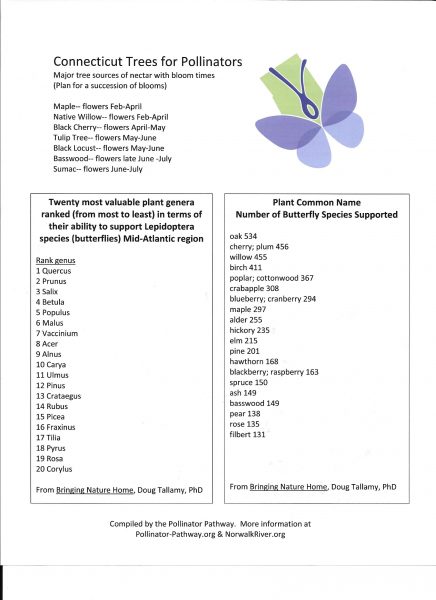
From Bringing Nature Home, By Doug Tallamy, this list of native trees includes the number of butterfly species supported by each and a ranking of the twenty most valuable Mid Atlantic plant genera in terms of their ability to support butterflies. Thanks to the Pollinator Pathway for compiling these lists!Continue reading“Connecticut Trees for Pollinators”
Create Your Own Butterfly Garden
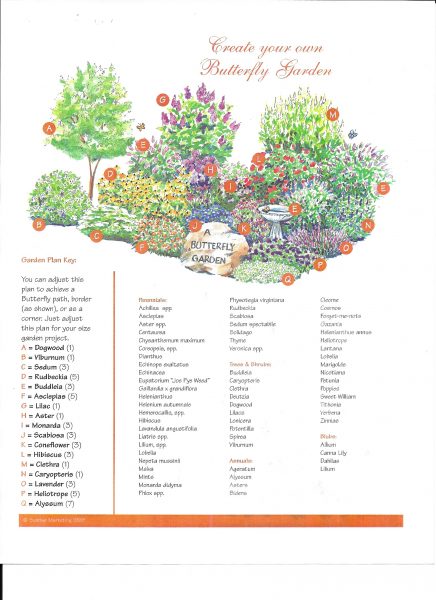
There are many plant varieties that butterflies love and this garden plan includes many of them. From trees to shrubs to perennials and annuals, the scheme would be a veritable magnet!Continue reading“Create Your Own Butterfly Garden”
How to Raise a Monarch Butterfly
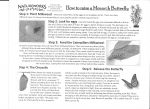
Natureworks in Northford, CT has created a 5 step process that starts with searching for Monarch eggs on milkweed plants and feeding the larvae leaves, watching the chrysalis emerge and finally releasing the adult butterfly. Take a look and consider adding milkweed to your landscape.Continue reading“How to Raise a Monarch Butterfly”
Best Plants for Butterflies
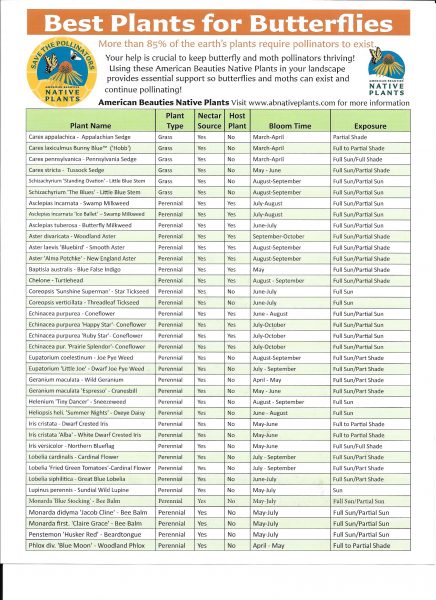
More than 85% of the earth’s plants require pollinators to exist. Using these plants in your landscape with keep our butterfly and moth pollinators thriving! Check out this list from American Beauty Native Plants that includes plant type, whether it is a nectar source and/or a host plant, its bloom time and preferred exposure.Continue reading“Best Plants for Butterflies”
Best Plants for Bees
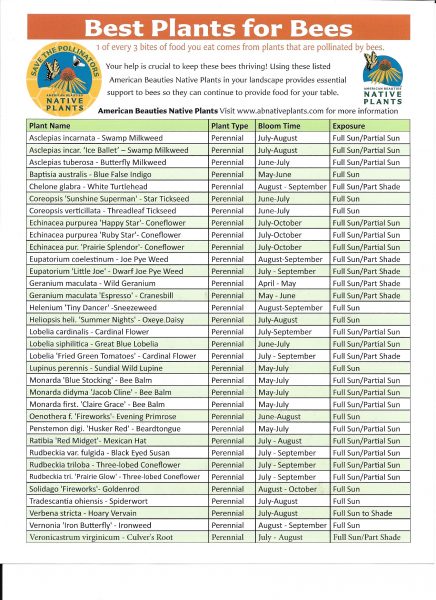
American Beauties Native Plants says, “1 out or every 3 bites of food you eat comes from plants that are pollinated by bees. Your help is crucial to keep these bees thriving!” See their list of native plants that includes plant type, bloom time and exposure requirements.Continue reading“Best Plants for Bees”
Help Us Help Our Pollinators!

Like other environmentally concerned organizations, Rowayton Gardeners has become increasingly aware of the significant dangers to humans as well as the environment in using hazardous synthetic pesticides like Roundup. We encourage all of our neighbors to avoid glyphosate and other toxic pesticides used in landscape management to kill crab grass, other weeds and pests. Synthetic fertilizers are also toxic to soil organisms and can be replaced with organic fertilizers, which provide gentle, slow release of nutrients that nourish the lawn. Continue reading“Help Us Help Our Pollinators!”
Pollinators Video
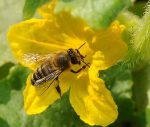
Join Us on the Pollinator Pathway!
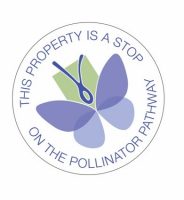
As you embark on maintenance of your lawn and garden this year, please make them part of the “Pollinator Pathway” that now stretches from Ridgefield to Greenwich and beyond. Municipalities and residents are recognizing the importance of bees, butterflies, birds and other pollinators to the overall health of our environment by switching to pesticide-free fertilizers and pest treatments. Yes, your lawn and garden can be lush and green without chemicals! Consider adding shrubs, trees and plants that are native to Connecticut, too, as they will better sustain our pollinator friends with friendly habitats and food. If you add just one native plant and swear off the chemicals, you will automatically become part of the Pollinator Pathway and eligible to post a small sign in your yard.Continue reading“Join Us on the Pollinator Pathway!”


